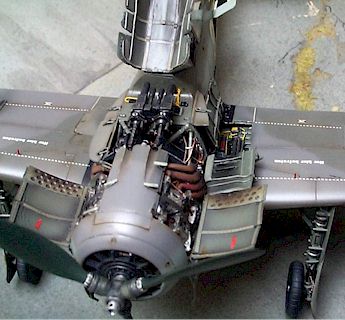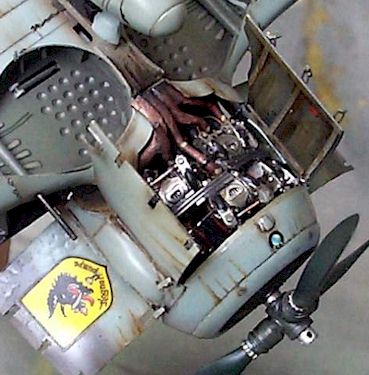Focke-Wulf Fw 190 A-8/R11 Nachtjäger
by Ricardo Dacoba
History
During the initial war years, the main equipment of the German night fighter units were twin-engined aircraft like the Ju 88 or Do 217. By summer 1943, the Luftwaffe devised a new night interception tactics in which single-engined day fighters were controlled by the ground radar. The system was called Wilde Sau, and two Jagdgeschwader were formed specifically for the purpose of night fighting – JG 301 and JG 302 . Part of the tactics was the decision to light up the skies as brightly as possible during an air raid. Along with the fires started from bombing this provided enough illumination to allow single-engine day fighters to attack enemy aircraft. The tactics proved successful in that it helped Germans to wave off the RAF bomber offensive on Berlin later the same year. Shortly after, an order was issued by Reichsmarschall Hermann Goering to triple the strength of Wilde Sau units. However it was not to materialize; as soon as spring of the following year it was decided that all available fighters were even more needed to combat American day bombers, and Wilde Sau units were converted to day operations.
One of the aircraft developments undertaken specifically for Wilde Sau was the night fighter version of Focke-Wulf 190As. The choice was made to equip the aircraft with FuG217 Neptun J-2 or FuG218 Neptun J-3 radar with external antennae. After some experiments, an R-11 factory conversion kit was issued for the Fw-190A-8. it contained the radar installation with external wing-mounted antennae, underbelly 300 liter auxiliary fuel tank, additional flame dampers over the exhaust stacks and a landing light.
The A-8 itself represented the peak of development for the line of radial-engined Fw-190s, and was the most produced subtype of the ”A” version. Compared to early models, it accumulated many improvements gained from combat experience. Main recognition elements of this subtype are:
for the line of radial-engined Fw-190s, and was the most produced subtype of the ”A” version. Compared to early models, it accumulated many improvements gained from combat experience. Main recognition elements of this subtype are:
- strengthened universal wing which could accommodate a total of four cannon in various configurations (introduced with A-6)
- bulged top cowling panel housing two MG 131 heavy calibre machine guns (introduced with A-7)
- the new Revi 16B gunsight replacing Revi C/12D (introduced with A-7)
- strengthened ”solid” wheel hubs (introduced with A-7)
- MW50 water-methanol installation with 118-litre tank mounted behind the cockpit and its oval access panel on fuselage underside
- auxiliary fuel tank mount ETC 501 was moved forward by some 20 cm (8 inches) to balance the weight of MW50 tank. With A-8, it was also introduced as standard on all production aircraft
- New FuG 16ZY radio resulted in two new antennae – the round direction-finding loop below the rear fuselage, and the wooden Morane type underneath the port wing
- The pitot tube was moved from around mid-chord to the tip of starboard wing.
Building the model
I used two kits for this project, the rest is scratchbuilt. The kits were 1/48 Dragon Master Series Fw 190A-8 and Aires BMW 801 resin engine.
Dragon’s kit of the Focke-Wulf fighter is correct in general lines. The bad news is poor quality of plastic and fit problems. The Aires engine kit is excellent, no further comments!
To describe the step-by-step development of the project and the modifications I made would be somewhat extensive. I’ll limit myself to pointing out that almost all modifications were performed solely by scratchbuilding. I used only very few photoetched metal parts – rudder pedals, seat belts and of course those coming with the Aires kit. All other components are were created with classic modelling techniques, using sheet styrene, wire, fine tubing and other scrap bits.
There were many areas of attention: open port wing cannon bay, radio compartment in the rear fuselage with opened access door on the port side, fuselage armament bay with two exposed MG 131 machine guns, wheel wells, the cockpit, landing flaps, the auxiliary tank mount, propeller and of course all opened panels and hatches.
The most complicated part of the project was the engine and fixing it to the model. The Aires kit is state-of-the-art of resin moulding. Exactly reflecting the Fw-190A engine installation, it contains details like exhaust pipes, the cooling fan, cowling mounting ring and rear engine bock with all accessories. The etched fret provides tiny things like ignition harness and braces between cylinders. The quality of moulding is very good, with no surface flaws or air bubbles.
engine and fixing it to the model. The Aires kit is state-of-the-art of resin moulding. Exactly reflecting the Fw-190A engine installation, it contains details like exhaust pipes, the cooling fan, cowling mounting ring and rear engine bock with all accessories. The etched fret provides tiny things like ignition harness and braces between cylinders. The quality of moulding is very good, with no surface flaws or air bubbles.
Consequently, building the engine became a modelling project in its own right, requiring care and patience when assembling and painting. Altogether there were about 60 resin parts – including eighteen separate cylinders and as many individual exhaust pipes. Each one of them had do be dry-fitted and aligned, all the time checking against the modified cowling of the Dragon kit.
The superdetailing project of this magnitude requires good preparation. Quality reference photos and drawings are essential, especially of the areas to receive extra detail, as are the cutaway drawings and general understanding of various installations and their modus operandi.
Then you need time. I spent one hour a day in the course of a year to complete my Focke-Wulf. That not to say that I haven’t had fun – indeed, there was a lot of satisfaction in scratchbuilding each subassembly. I am also most happy with the end result.
Painting
I opted for the paint scheme featured in the Dragon kit. The “white 9” of 1./NJGr 10 was flown by Günter Migge. This particular aircraft is relatively well-researched and featured the R-11 conversion and full armament of two MG 131 and four MG 151/20 in the wings.
Basic camouflage is the standard fighter scheme of two greys RLM 74 and 75 on upper surfaces and RLM 76 underside. The ”white 9” carried the yellow-and-black Wilde Sau badge on both sides of the cowling and had a black triangular panel behind engine exhausts.
I used acrylic colors for the camouflage and enamels for the engine and other detailed areas.
The camouflage colors were obtained by mixing different shades of Tamiya acrylics using reference color samples produced with Xtracolor – which to my understanding are the most accurate renditions of authentic Luftwaffe shades.
Various details were painted as per reference materials.
Bibliography
There are a lot of valuable books on Fw 190, here are the three that I found most useful during this project:
- German Aircraft Interiors 1935-1945 Volume 1 Dayfighters by Kenneth A. Merrick
- Warplanes of the Luftwaffe by David Donald
- German Aircraft Landing Gear: A Detailed Study of German World War II Combat Aircraft by Gunther Sengfelder
This article was originally published in IPMS Stockholms Magazine in September 2001.





